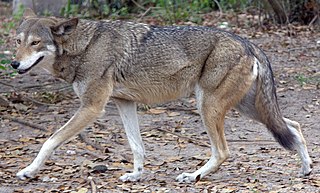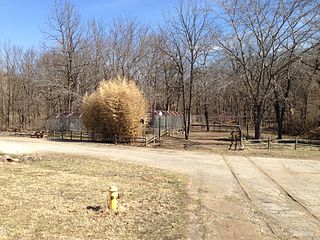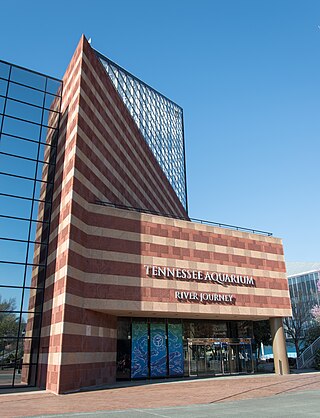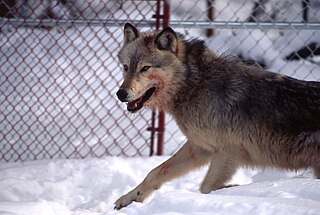
The red wolf is a canine native to the southeastern United States. Its size is intermediate between the coyote and gray wolf.

Chattanooga is a city in and the county seat of Hamilton County, Tennessee, United States. It is located along the Tennessee River, and borders Georgia to the south. With a population of 181,099 in 2020, it is Tennessee's fourth-largest city and one of the two principal cities of East Tennessee, along with Knoxville. It anchors the Chattanooga metropolitan area, Tennessee's fourth-largest metropolitan statistical area, as well as a larger three-state area that includes Southeast Tennessee, Northwest Georgia, and Northeast Alabama.

An arboretum is a botanical collection composed exclusively of trees of a variety of species. Originally mostly created as a section in a larger garden or park for specimens of mostly non-local species, many modern arboreta are in botanical gardens as living collections of woody plants and is intended at least in part for scientific study.

The Endangered Wolf Center is a non-profit wildlife facility in Eureka, Missouri, United States, near St. Louis that is dedicated to preserving and reintroducing to the wild critically endangered species of wolves. It is certified by the Association of Zoos and Aquariums (AZA). Visitors can tour the facility by making a reservation.

The Ethiopian wolf, also called the red jackal, the Simien jackal or Simien fox, is a canine native to the Ethiopian Highlands. In southeastern Ethiopia it is also known as the horse jackal. It is similar to the coyote in size and build, and is distinguished by its long and narrow skull, and its red and white fur. Unlike most large canids, which are widespread, generalist feeders, the Ethiopian wolf is a highly specialised feeder of Afroalpine rodents with very specific habitat requirements. It is one of the world's rarest canids, and Africa's most endangered carnivore.

Point Defiance Zoo & Aquarium (PDZA) is the only combined zoo and aquarium in the Pacific Northwest, located in Tacoma, Washington, US, owned by Metro Parks Tacoma. Situated on 29 acres (12 ha) in Tacoma's Point Defiance Park, the zoo and aquarium are home to over 9,000 specimens representing 367 animal species. The zoo was founded in 1905; the aquarium was founded in 1935 near Commencement Bay and relocated within the zoo in 1963. Both are accredited by the Association of Zoos and Aquariums. In Pierce County, Washington, this is said to be one of the most popular tourist destinations, bringing in over more than 600,000 visitors per year.

The Mesker Park Zoo and Botanic Garden is a zoo that opened in 1928 in Evansville, Indiana, United States. It is located in Mesker Park on Evansville's northwest side and is run by the City of Evansville.
Royal Botanical Gardens (RBG) is headquartered in Burlington owning extensive environmental protection areas, historic sites and culturally relevant gardens in Hamilton, Ontario, Canada. It is one of the major tourist attractions between Niagara Falls and Toronto, as well as a significant local and regional horticultural, education, conservation, and scientific resource. The mandate is derived by a Provincial Act of 1941 centred on human interaction with the natural world and protection of environmentally significant lands that form the western tip of Lake Ontario. Royal Botanical Gardens spans an area of about 10 km by 4 km, dominated by two coastal wetlands, and glacial-carved landscapes that extend from the lake up to the Niagara Escarpment plateau. The various gardens and natural areas are accessed through nine public entrance locations. It is one of several Prescribed Public Bodies listed under the Ontario Heritage Act.

The conservation status of a group of organisms indicates whether the group still exists and how likely the group is to become extinct in the near future. Many factors are taken into account when assessing conservation status: not simply the number of individuals remaining, but the overall increase or decrease in the population over time, breeding success rates, and known threats. Various systems of conservation status are in use at international, multi-country, national and local levels, as well as for consumer use such as sustainable seafood advisory lists and certification. The two international systems are by the International Union for Conservation of Nature (IUCN) and The Convention on International Trade in Endangered Species of Wild Fauna and Flora (CITES).

The Mexican wolf, also known as the lobo, is a subspecies of gray wolf native to southeastern Arizona and southern New Mexico in the United States, and northern Mexico. It once also ranged into western Texas. It is the smallest of North America's gray wolves, and is similar to the Great Plains wolf, though it is distinguished by its smaller, narrower skull and its darker pelt, which is yellowish-gray and heavily clouded with black over the back and tail. Its ancestors were likely the first gray wolves to enter North America after the extinction of the Beringian wolf, as indicated by its southern range and basal physical and genetic characteristics.

The Tennessee Aquarium is a non-profit public aquarium located in Chattanooga, Tennessee, United States. It opened in 1992 on the banks of the Tennessee River in downtown Chattanooga, with a major expansion added in 2005. The aquarium, which has been accredited by the Association of Zoos and Aquariums (AZA) since 1993, is home to more than 12,000 animals representing almost 800 species.

Hoyt Arboretum is a public park in Portland, Oregon, which is part of the complex of parks collectively known as Washington Park. The 189-acre (76 ha) arboretum is located atop a ridge in the Tualatin Mountains two miles (3.2 km) west of downtown Portland. Hoyt has 12 miles of hiking trails, two miles of accessible paved trails, and is open free to the public all year. About 350,000 visitors per year visit the arboretum.

The Morton Arboretum, in Lisle, Illinois, United States, is a public garden and outdoor museum with a library, herbarium, and program in tree research including the Center for Tree Science. Its grounds, covering 1,700 acres, include cataloged collections of trees and other living plants, gardens, and restored areas, among which is a restored tallgrass prairie. The living collections include more than 4,100 different plant species. There are more than 200,000 cataloged plants.
ZooMontana is a 70-acre (28 ha) zoo located in Billings, Montana, U.S. and is Montana's only zoo and botanical park. The zoo currently maintains nearly 100 animals, representing 58 species. These animals all live in habitats designed to imitate their natural habitats. The zoo was incorporated and established as a nonprofit 501(c)(3) organization in 1992. It focuses on year-round wildlife native to Montana, the Rocky Mountains, and other cold temperature regions at or above the 45th parallel. Indoor habitats include animals from around the world. The zoo hosts over 160,000 visitors per year.
The Chattanooga Zoo at Warner Park is a 13-acre (5.3 ha) zoological park located in Warner Park in Chattanooga, Tennessee. The zoo was established in 1937 by the City of Chattanooga with the construction of two 4 by 6 feet cages for rhesus monkeys. The zoo has been accredited by the Association of Zoos and Aquariums (AZA) since 1998.

Wolf reintroduction involves the reintroduction of a portion of grey wolves in areas where native wolves have been extirpated. More than 30 subspecies of Canis lupus have been recognized, and grey wolves, as colloquially understood, comprise nondomestic/feral subspecies. Reintroduction is only considered where large tracts of suitable wilderness still exist and where certain prey species are abundant enough to support a predetermined wolf population.

California Wolf Center is a 501(c)3 nonprofit located 50 miles east of San Diego, near the town of Julian, California. It is a conservation, education, and research center dedicated to wolf recovery in the wild. They are a statewide organization with staff and volunteers throughout California striving to pave the way for the return of wolves in California. Founded in 1977 to educate the public about wildlife and ecology, the center is currently home to several packs of gray wolves, some of which play an important role in educational programs. These wolves serve as ambassadors representing wolves in the wild. The center also hosts highly endangered Mexican gray wolves, now being reintroduced into the southwestern United States.

Chattanooga Red Wolves Soccer Club is an American professional soccer club based in Chattanooga, Tennessee. They are a founding member of USL League One, the third division of American men's soccer. The club was announced as a member of League One on August 1, 2018. The Red Wolves play their homes games at CHI Memorial Stadium, Tennessee's first professional soccer-specific stadium. The club is also a founding member of the USL W League, which the Chattanooga Lady Red Wolves participate in. The club also fields two semi-professional teams called the Dalton Red Wolves and Park City Red Wolves in USL League Two.
Omar Hernandez Chavarria is an American college soccer player who last played for Mercer University. He had previously played for the academy teams of Chattanooga FC and Atlanta United FC and collegiately for Wake Forest University.
















